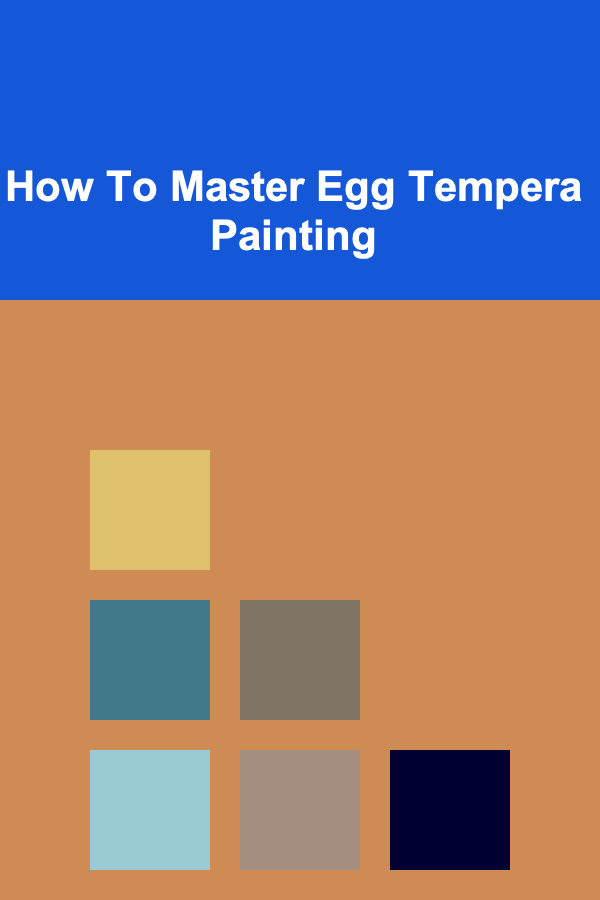
How To Master Egg Tempera Painting
ebook include PDF & Audio bundle (Micro Guide)
$12.99$7.99
Limited Time Offer! Order within the next:

Egg tempera painting is one of the oldest and most revered methods in the world of fine art. This technique, which dates back to the ancient Egyptian and Greek civilizations, experienced a renaissance in Europe during the Middle Ages and the Renaissance. It is a medium known for its luminous colors, fine detail, and ability to produce exquisite textures and surfaces.
Learning how to master egg tempera painting requires patience, skill, and a deep understanding of the materials involved. In this article, we will explore the origins of egg tempera, the materials and tools required, the step-by-step process of creating an egg tempera painting, and techniques to refine your skills and achieve masterful results.
The History and Evolution of Egg Tempera
Egg tempera painting has a rich history that spans thousands of years. The use of egg yolk as a binder for pigment is believed to have been first used by the ancient Egyptians and Greeks, though its use became more widespread in medieval Europe.
In the early days of egg tempera, artists would mix egg yolk with natural pigments, water, and sometimes a small amount of vinegar or gum to create a paint mixture. The results were not only long-lasting but allowed for vibrant color and sharp detail. This combination made egg tempera particularly suitable for the creation of detailed icons and religious paintings.
By the time of the Italian Renaissance, egg tempera was the dominant painting medium. Artists such as Giotto, Botticelli, and Fra Angelico perfected its use. However, with the invention of oil paint in the 15th century, egg tempera began to fall out of favor, as oil paints allowed for greater flexibility and blending. Despite this shift, the technique of egg tempera never completely disappeared and has seen a resurgence in contemporary art.
Understanding Egg Tempera
Egg tempera is a painting technique where egg yolk is used as a binder to hold pigment particles together. The egg yolk is mixed with water, creating a creamy emulsion that can be used to apply fine layers of paint onto a surface. The paints are typically applied in thin, translucent layers, allowing light to pass through the paint and reflect off the surface beneath, giving egg tempera its characteristic luminosity.
This technique differs from oil painting in several key ways. While oil paint dries slowly and allows for smooth blending of colors, egg tempera dries almost immediately and is best used in small, controlled strokes. As a result, egg tempera often results in highly detailed works with visible brushstrokes, which can be both a challenge and a strength for the artist.
Materials and Tools for Egg Tempera
To begin mastering egg tempera painting, it's essential to familiarize yourself with the materials and tools required. Here's a comprehensive list of what you'll need:
1. Pigments
The foundation of any painting is the pigment. In egg tempera, dry powdered pigments are mixed with the egg yolk to create the paint. There are many types of pigments available, ranging from earth pigments like ochre to vibrant synthetic pigments. These pigments must be ground very finely to create the smooth texture that egg tempera requires.
Some commonly used pigments in egg tempera are:
- Ultramarine Blue
- Cadmium Red
- Yellow Ochre
- Cobalt Violet
- Titanium White
2. Egg Yolk
Egg yolk is the primary binder used in egg tempera. It is separated from the egg white, and only the yolk is used. Egg yolk contains both water and lipids, which allow it to bind with the pigments and create the necessary emulsion. Fresh eggs are preferred, as older eggs may result in an uneven mixture.
3. Water
Water is mixed with egg yolk to help create a smooth, workable consistency for the paint. The amount of water added varies based on the texture and opacity desired by the artist.
4. Brushes
Egg tempera is typically applied using small, fine brushes. Natural hair brushes, like those made from squirrel or sable, are ideal as they allow for precise control and fine detail. The bristles of the brush should be stiff enough to hold the paint but soft enough to create smooth, controlled strokes.
5. Surface
Egg tempera is traditionally applied to rigid surfaces like wood panels, which are prepared with a layer of gesso. The gesso serves as a smooth, absorbent surface for the paint, which helps it adhere better and ensures longevity. Modern artists sometimes use canvas, but wood remains the preferred surface for traditional egg tempera painting.
6. Gesso
Gesso is a mixture of chalk or gypsum, water, and an adhesive (often rabbit skin glue) that is applied to a wood panel before painting. It provides a smooth and absorbent surface that allows the egg tempera to adhere properly. The gesso should be applied in thin layers, with each layer being sanded smooth before the next one is added.
7. Varnish
Once the painting is complete and dried, it is often coated with a protective varnish. This varnish helps protect the delicate layers of egg tempera from dust and UV damage, ensuring that the colors remain vibrant over time.
The Process of Creating an Egg Tempera Painting
Now that we understand the materials involved, let's dive into the step-by-step process of creating an egg tempera painting. Each step requires care and precision, as egg tempera is known for its fine details and thin, layered approach.
Step 1: Preparing the Surface
The first step in creating an egg tempera painting is preparing the surface. Traditionally, egg tempera is applied to wooden panels, which are prepared with multiple layers of gesso. To start, you will need to:
- Sand the wooden panel to ensure it is smooth.
- Apply the gesso in thin, even layers, allowing each layer to dry completely before applying the next. Typically, three to five layers of gesso are sufficient.
- Sand the gesso between each layer to achieve a smooth, even surface. The final layer should be particularly smooth and ready for painting.
Some modern artists also use canvas, though it's not as common for egg tempera.
Step 2: Mixing the Egg Tempera Paint
Once your surface is prepared, it's time to mix your paint. The ratio of egg yolk to water is essential for creating the right consistency. A typical recipe for mixing egg tempera is as follows:
- Separate the egg yolk from the egg white. You only need the yolk for this process.
- Gently beat the egg yolk to break it up.
- Add a small amount of water (usually about half the volume of the egg yolk) and mix it to create an emulsion.
- Gradually add powdered pigments into the emulsion, mixing thoroughly to create a smooth paint mixture. The more pigment you add, the more opaque the paint will become.
Step 3: Drawing and Underpainting
Before applying paint, it is common to sketch the composition on the surface using a pencil or charcoal. Once the basic outline is in place, an underpainting is often done to establish the tonal values and create depth.
- Use a diluted mix of egg tempera to paint the underpainting, starting with light colors and working towards darker tones. This underpainting will help guide the application of subsequent layers of color.
Step 4: Layering the Paint
Egg tempera is applied in thin, transparent layers, with each layer allowing the underlying colors to show through. This layered approach creates a rich depth of color that is characteristic of egg tempera painting.
- Start by painting the lightest colors first, gradually adding darker hues on top. Since egg tempera dries quickly, you can build up multiple layers without worrying about smudging.
- Use fine, controlled brushstrokes to create detail and texture. The brushstrokes will remain visible in the final piece, contributing to the overall aesthetic.
- Allow each layer to dry before applying the next one. This step is crucial, as it ensures that each layer of paint is fully set before additional layers are applied.
Step 5: Detailing and Refining
As the layers of paint build up, you can start adding intricate details. Use small brushes to work on fine features such as facial expressions, textures, and patterns. Egg tempera is well-suited to fine details, as it allows for sharp, defined lines and smooth gradations of color.
- Continue layering thin coats of paint, gradually refining the details and adding depth.
- If necessary, you can use a technique called "glazing" in which you apply thin layers of transparent paint over dry, opaque layers to adjust colors and create depth.
Step 6: Final Touches and Varnishing
Once the painting is complete, allow it to dry fully. Egg tempera dries relatively quickly, but it is important to ensure that all layers are completely dry before proceeding.
- Once the painting is dry, apply a protective varnish. The varnish will protect the egg tempera from dust and UV damage, helping it retain its vibrancy for years.
- Allow the varnish to dry before handling the painting.
Techniques for Mastering Egg Tempera Painting
Mastering egg tempera painting takes time, practice, and an understanding of the medium's nuances. Here are some advanced techniques to help you refine your egg tempera skills:
1. Scumbling
Scumbling is a technique in which a thin layer of opaque or semi-opaque paint is applied over a dry layer of paint. This technique is used to soften transitions, create texture, or lighten areas of the painting without disturbing the layers beneath.
2. Underpainting with Grisaille
Grisaille is a monochromatic underpainting technique in which shades of gray are used to establish tonal values before adding color layers. This approach can help achieve greater depth and realism in the finished piece.
3. Glazing
Glazing is the process of applying transparent layers of paint over a dry base layer. The glaze allows the underlying color to show through, creating depth and luminosity in the painting. Glazing is particularly useful for achieving subtle tonal shifts or for enhancing the vibrancy of certain areas.
4. Creating Fine Detail
Egg tempera is ideal for creating fine details, but this requires precision and control. Use small brushes and work in thin layers to gradually build up detail. Take your time and focus on accuracy, as each layer contributes to the overall effect.
Conclusion
Mastering egg tempera painting is a rewarding journey that requires patience, practice, and an understanding of the medium. While it may seem like a time-consuming process, the results can be breathtaking, with luminous colors and fine details that are unmatched by other painting techniques. Whether you're working on a religious icon, a portrait, or a landscape, egg tempera offers unparalleled precision and beauty.
By carefully following the steps, using the right materials, and refining your technique over time, you can become a master of egg tempera painting and produce works of art that will stand the test of time.

How to Create a Statement Wall Without Spending Too Much
Read More
Top Ways to Profit from Deep Learning Projects
Read More
Why Creating a Personal Space for Reflection is Beneficial
Read More
How To Analyze Your Own Gameplay for Flaws
Read More
How To Find Your Next Binge-Worthy Drama Series
Read More
How to Time Block for Studying Effectively
Read MoreOther Products

How to Create a Statement Wall Without Spending Too Much
Read More
Top Ways to Profit from Deep Learning Projects
Read More
Why Creating a Personal Space for Reflection is Beneficial
Read More
How To Analyze Your Own Gameplay for Flaws
Read More
How To Find Your Next Binge-Worthy Drama Series
Read More